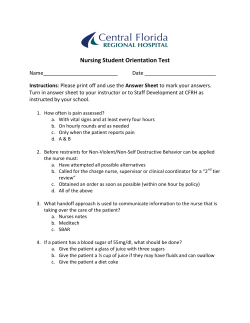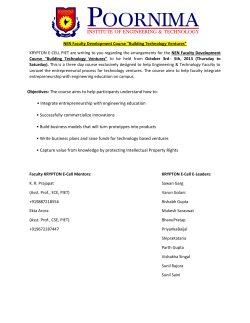
Systems and Models in Curriculum Development
Systems and Models in Curriculum Development In this lesson, we will focus on the systems approach to curriculum development. By the end of this lesson, you should be able to select a model that is most appropriate for the setting for which you are designing or evaluating curriculum. Curriculum development is often done in a haphazard manner. May have a hidden agenda due to factors such as: to keep or create jobs sell materials and equipment fulfill political or social agenda fit a particular instructor’s preferences A systematic-model approach to curriculum design may be the key to avoiding these undesirable influences. Let’s take a look at “Systems” And “Models” What is a system?? A system is a collection of elements, interacting with each other to achieve a common goal. Crunkilton and Finch (1999) A system consists of five elements. These are…?? Input-fuel, air, electrical charge Output-movement, spark Feedback-sounds, temperature Environment-operating environment including ambient temperature, personnel Process-internal combustion, cooling, movement What about human resource systems?? Input--? Output--? Feedback--? Environment--? Process--? Think about a human resource system at your organization—let’s say, staff development. What would be some of the components of each of these elements? For example, what input would be a part of staff development? Go to the Discussion Board and share your thoughts on these elements. A Model is…?? See page 29 in your text. A simplified, yet communicable representation of a real-world setting or situation. May be synonymous with design. It is an organized way of accomplishing a goal or task. Furthermore, a model should be... Practical Realistic Efficient Inclusive Let’s look at some systematic curriculum planning models. The Systems Model for Performance Improvement This model, formerly the Technology Training System (TTS), is designed to separate training problems from non-training problems. Highly dependent upon front-end analysis, it is used to decide “Whether management actions, developmental efforts, environmental forces, or some combination of these will affect the change in performance. See page 30 in your text. There are five phases to the Performance Improvement Model... Analyze Design Develop Implement Control The Analysis phase focuses on two key components •Organizational performance diagnosis •What are the desired performances? •What are the actual performances? •What improvements need to be made? •Work expertise documentation •Gathering information •Recording expertise requirements needed to perform on the job. The Analysis phase is heavily dependent on front-end analysis. Front-end analysis is a systematic means of seeking solutions to human performance problems while keeping in mind the problem’s definition and characteristics, as well as alternate courses of action. Front-end analysis involves... Needs assessments Task analyses ID of work or job requirements Proposal development Administrative buy-in During the Design Phase... Program and lessons are designed Designs are based on results of the analysis phase Needs are matched with restraints During the Develop Phase... New materials are developed Existing materials are revised During the Implement Phase Management and training plans are enacted Training actually takes place, when necessary During the Control Phase Training is evaluated Results are reported Training is revised Trainee’s proficiency is monitored and maintained on the job (follow-up) The Performance-Based Instructional Design System (PBID) Designed to provide a systematic means of developing instruction that would ensure the performance capabilities of the learner. See page 36 in your text. Crunkilton and Finch (1999) Steps in the PBID include... Program Description – intent and context Content Analysis – ID of possible content Content Selection – what will the content be Content Sequencing – how will it be sequenced Steps in the PBID include... Lesson Structuring – considers principles of learning and possible thematic considerations (next slide) Lesson Delivery Formatting – traditional, CBT, individualized Development of Evaluation Procedure – includes quality assurance and feedback A Thematic Curriculum Framework is... A set of organized experiences such as programs, courses, and other school-sponsored activities that provide students with exposure to a broad, predominate theme. Examples may include specific health settings, aerospace, maritime, etc. See page 38 in your text. The Tylerian Model This model was developed by Ralph Tyler to simplify the curriculum development process. Consists of four primary steps… Development of performance objectives Development of activities Organization of activities Evaluation The Tylerian Model was expanded by Doll (1986)to include: Statement of need, based on assessment Statement of objective Content list and organizational plan Description of learning experiences Evaluation plan Plan to solicit support for the curriculum The final model that we will look at is the Ten-Step Curriculum Planning Model. This model first appeared in the NASSP Bulletin in 1984 in an article by Zenger and Zenger. It is an inclusive, organized approach that certainly meets the definition of “systematic model.” It is commonly used in the school setting. The article is not available on the web as a full text article, therefore, I will mail a copy to you. Evaluate Curriculum Implement New Curriculum Design New Curriculum Identify Curricular Need Ten-Step Curriculum Planning Process Model Select New Curriculum Identify New Curriculum Develop Goals and Objectives Identify Resources and Restraints Organize Curriculum Committees Establish Roles of Personnel When using the “Ten-Step” Model, the process... may or may not include all steps. may begin or end at any of the steps. steps may be repeated as necessary evaluation is a critical component of all steps A quick wrap up... Models are useful because they provide guidance and structure. Systems models bring various groups, individuals, information, and activities together to achieve the goal and to provide continuous feedback in order to improve the curriculum. And that’s it. Be sure to check the website for assignments related to this lesson. Let me know if you have any questions. Use the discussion board to post comments and discuss these issues.
© Copyright 2025





















